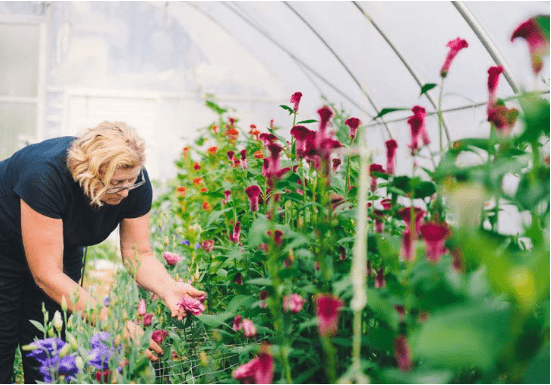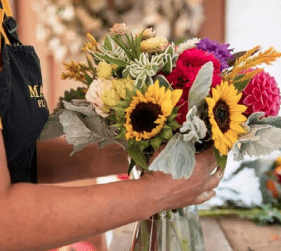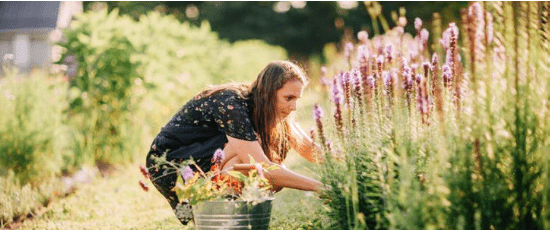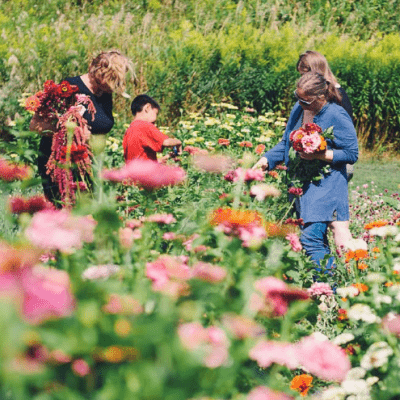By: Theresa Schumilas
The market for field-grown cut flowers in Ontario is estimated at $6M and growing rapidly.
This past spring I interviewed 10 established Ontario cut flower farmers about the opportunities and challenges they see in various marketing channels, and the impacts of COVID-19.

Bulk Flowers to Designers
Selling wholesale to designers can move a lot of flowers quickly, but it has its challenges and it’s not usually the place to start. As Sas, of Floralora Flowers notes, “It takes a while for designers to trust you, and the biggest challenge is PERFECTION. Brenda from Flowers of the Field concurs, and stresses that you have to be prepared for “the fussy factor.”
It can be difficult to find sufficient numbers of designers outside of the
GTA who want locally grown cuts. As Kevin and Heidi from Edgebrook Farms explain, “The higher population there means some designers have four or five events in a given weekend. That’s a lot of flowers.”
Across Ontario, growers are working to form various types of collectives to sell cut flowers to designers in on-line marketplaces. The Local Flower Collective (TLFC) in Toronto was the first of these. By working together in collectives growers can ‘cover each other’ to ensure reliable supply over a long season. TLFC uses the Open Food Network platform to do this because of its affordability (free for the marketplace suppliers) and flexibility – growers can also have multiple online stores and marketplaces selling from the same inventory.
Small Stores, Hubs, Permanent Farmers’ Markets
Market-type stores, especially in tourism areas, are a second wholesale channel pursued by farmers like Heidi of Edgebrook Farms and Janis of Harris Flower Farm. Flowers are a spontaneous purchase, and these kinds of stores cater to that. This sales channel has multiple benefits: grower choice, no consignment, weekly drop off, and they run all season long.
The challenge, as Heidi notes, is that you are surrendering your brand to someone else. She stresses that education about handling and storage is important, or your brand becomes associated with flowers that only last a few days.
Flower CSAs or Subscriptions
Flower CSAs (aka “subscriptions”) are growing very fast and right now demand is greater than supply in most areas. They also couple nicely with other farm products, notes Susan from Hawthorn Ridge Heritage Farm.
These are typically pre-purchased subscriptions, where the farmer decides on the styles of bouquets offered, the price, and the delivery/pick-up options. Flower CSAs come in all sizes. The farms I interviewed offered anywhere between 30 and 300 subscriptions for 2021, and sold out before January.
The primary challenge with flower subscriptions is that demand for flowers falls off in the middle of summer when people are away at cottages. Those are the months with the most plentiful and easily grown flowers.
Farmers’ Markets
Markets are a great channel if you are the only vendor with flowers and the weather is fair. But if there are other growers selling flowers as ‘loss leaders’ or it is stifling hot, farmers’ markets are a challenging way to sell flowers. Some growers sell pre-made bouquets while others bring bulk flowers and invite customers to make their own bouquet. Regardless, as Hilde from Makkink Flower Farm notes, “It’s all about the display. You have to over-pick and over- supply to stay looking good all day and don’t even bother taking things that will wilt in the heat.” The only thing worse than bringing home a lot of flowers is bringing home a lot of wilted flowers.
Farmers’ markets are a great way for a new flower farmer to build a following and get started. However, the number of non-flower vendors who offer bunches ‘on the side’ as a loss-leader results in serious flower farmers adding or shifting marketing channels.

Flower Tourism and PYO
Flower agritourism, including Pick- Your-Own (PYO) flowers, workshops and other events, is another fast growing cut flower marketing channel. At Garden Party we’ve found this to be the perfect companion to wholesale designer sales. People pick entirely different flowers from what designers order. This is also a very flexible and scalable channel. At Garden Party, we limit to six cars and five picking times per week. At the opposite end of the spectrum, at Edgebrook Farms, Heidi and Kevin are developing a full-blown flower destination for hundreds of visitors.
If you are a creative person, there is lots of room to innovate in this channel. The main advantage (other than you get to stay on the farm) is the WOW factor. As Hilde notes, “people are definitely looking for flowers as an experience.”
Weddings
Offering full service weddings, where the farmer not only supplies the flowers, but also makes the arrangements and does the installations on site, is a very profitable channel for a flower farm. But it also has the most challenges. Mention weddings to a group of flower farmers and you’ll immediately see eyes roll.
More than any other marketing channel, weddings are affected by COVID. In 2020 there were postponements, followed by re-bookings. Those re-bookings are now becoming re- postponements, cancellations, and scaled down events. “I don’t really even know how many weddings I have going on this season” confesses Janis. “There are 50 booked right now, but that’s not including the re-schedules. It’s just chaos.” Heather concurs. Feeder Flower Farm has had to hire someone just to do the COVID-related scheduling and re-scheduling.
Each time a wedding is re-scheduled, the farmer must re-plan the flowers. That August 2020 blush palette featuring dahlias is now happening in July 2021– when focal flowers are sunflowers or hydrangeas. This requires an entirely new consultation with the bride.
Many weddings are now becoming elopements or small events, so the purchase is scaling down. When a wedding scales downward from $2000 to $500 or less, the farmer is still putting in the same planning time. Indeed, the flower revenue from elopement weddings is now approaching ‘DIY’ prices. At Garden Party, bulk flowers picked, cleaned and conditioned for a wedding party who will design their own arrangements average $300 – without any of the design work or client hand holding.
Conclusion
All the farmers interviewed felt that in recent years flower farming has become rather romanticized on social media. This hype has led to a significant increase in new flower farms. “It’s a happening thing” summarizes Harriet of White Creek Flower Farm. Heidi from Edgebrook Farms concurs: “In the past two years, on every side road, in every direction, there is a new flower farm.”
It is exciting to see a new market for local farmers in formation. It reminds of the early days in the organic and local food movements. The key thing we learned then was that farmers had to collaborate to educate buyers and grow the demand. Without attention to both the supply and demand sides of the equation, we risk product sitting unsold in our fields.

This article was originally published in the Summer 2021 issue of the EFAO member publication, Ecological Farming in Ontario.

